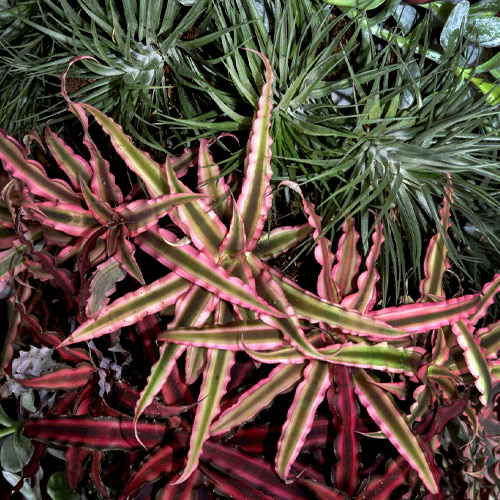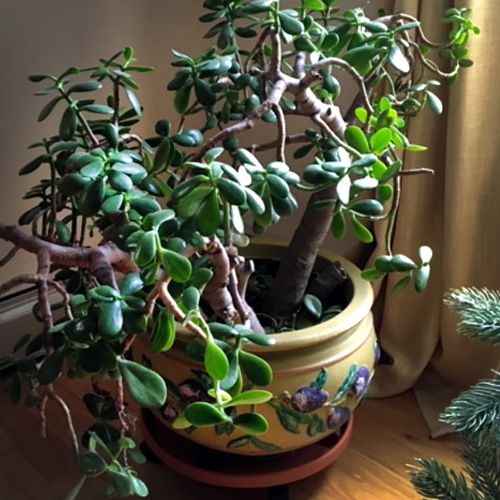Here’s one cure for cabin fever—
grow some cool indoor plants and stage them like they’re pieces of art. Potted plants can sit on the floor, a bookcase, a shelf, a counter, suspended from the ceiling, or attached to a wall. We don’t often think of “decorating” with plants, but it’s an opportunity to use them as displays, whether your style is minimalist, cottage, formal, funky, or vintage.

There’s the beauty of a fern with its delicate fronds or an African violet with a cluster of vibrant flowers. Some, like jasmine, add fragrance to a room. Ivy and pothos can send their glossy foliage trailing from the top of a bookshelf. And, you don’t have to be a gardening guru to get them to thrive.
There are plenty of places to stage plants indoors. They can go near the entryway to greet guests. Or place them on tables in the kitchen, dining room, or bedside. How about that awkward, empty space that you don’t know what to do with? Accessorize it with a tall plant in a large attractive pot.
For the vintage enthusiast, there are Victorian wicker planters for ferns. For the no-nonsense minimalist, there are tall brushed stainless steel and ceramic cylinders to hold trailing or upright plants. Into vintage things? You can find plenty of 1950s-era plant pots in resale shops. Fill them with African violets or cyclamen and group them together for a fun and funky display.
Sansevieria
The old-fashioned “mother-in-law’s tongue” (aka snake plant) adored by the Victorians for their parlors, has become popular once again—but for a different reason. The foliage is dramatic and looks like contemporary sculpture. There are several species and cultivars, but most have sword-shaped green leaves edged in yellow. Some have light gray-green horizontal stripes. Pop the plant in a tall vertical ceramic container and think of it as art—the upright succulent leaves rising to a dramatic 4-foot display. Easy to grow, they thrive on neglect, take up little room, and are quite stunning.
Aspidistra
Cast-iron plant is another oldie-but-goodie. Hardy and long-lived, aspidistra was a common houseplant in England during the early 1900s where it survived poor light and polluted air. Today, the long, lance-shaped leaves add a tropical touch to any room. The bonus: it survives with little light.
Ficus elastica
Rubber plants are noted for their leathery, glossy, dark green leaves that grow up to 12 inches long and 5 inches wide. Some varieties have burgundy foliage or green leaves with white ribs. One large specimen makes a striking addition to any room.
Pothos
Here’s a houseplant that never goes out of style. In the 1970s, it was often placed in macrame hangers hung from the ceiling. What’s old is new again because 50 years later, macrame hangers are back (along with bell bottoms and tie-dyed clothes). This tropical vine has heart-shaped leaves that may be marbled gold, variegated green and cream, chartreuse, or yellow. It’s one of the easiest houseplants to grow. It can trail down a bookcase or windowsill, grow horizontally on a mantle or climb up a trellis. If it outgrows the space, cut a few inches off the ends, place the cuttings in a jar of water where they’ll root—you’ll have free plants to give away to friends.
Tillandsia
Looking for a plant that requires little maintenance? The curious looking “air plants” fit that bill. Air plants are epiphytes (plants that grow on another plant but are not parasitic). For example, they can grow on tree trunks in tropical rainforests. They receive moisture and nutrients from the air. Like succulents, tillandsias have become wildly popular. No soil is needed. You can simply attach them to fishing line in bright indirect light where they can dangle from a thumbtack in the ceiling. They can be placed in wooden bowls, baskets, or in vertical wall gardens. Read more about topiary trees.
Alocasia and Colocasia
Elephant ears are impressive plants with leaves that often measure up to 2 feet wide. The foliage can be green to deep purple and near black. While they’re often used as outdoor tropical plants in the summer, they can be grown indoors where their substantial size makes a statement.
Crassula
Jade plants can live for decades indoors given the right conditions. They’re easygoing, low maintenance, and as they turn into shrubby specimens, they look like miniature trees. Some specimens have red-tipped green leaves while others are silvery grey and flattened.
Decorators often choose plants for a design effect, but you can’t choose a houseplant the same way you choose a bedspread or curtains. Most people who buy plants want to keep them for the long term. If you’ve got the most perfect spot indoors to display a palm tree, but it’s not the perfect spot for the tree, it’s going to fail. Think of houseplants as living things, not inanimate objects. Houseplant care tips will help out, especially if you’re a newbie plant parent.
Nina Koziol is a garden writer and horticulturist who lives and gardens in Palos Park, Illinois.





